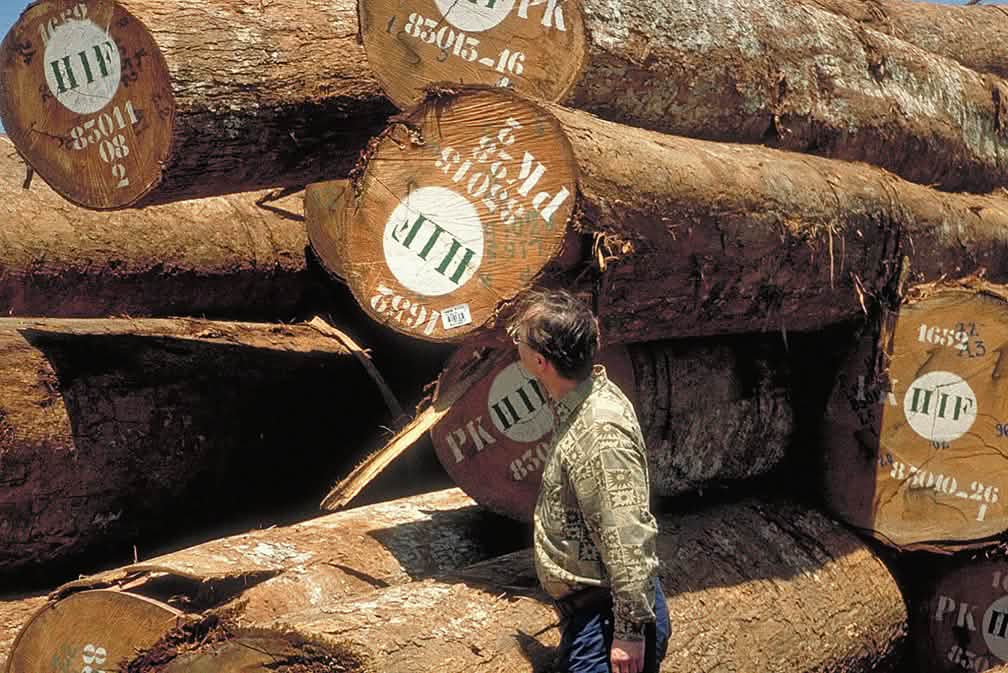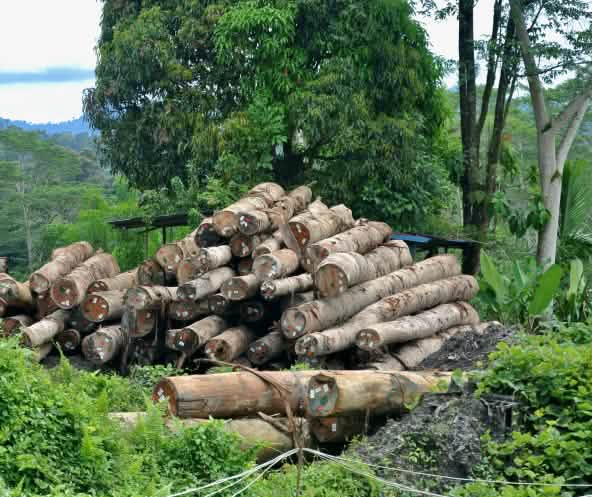
Questions and answers
After years of boycotts and awareness campaigns by environmentalists, tropical timber products had for a long time become synonymous with exploitation and plunder. As a result, their sales figures fell drastically. The industry has since polished up its image by promoting tropical timber from plantations and “sustainable forestry”. Garden furniture, buffet boards and broomsticks now bear seals like that of the FSC that claim to certify the wood’s ecological soundness. Consumers are confused, and many companies and municipalities do not know how to proceed. Is it possible to go back to buying tropical timber with a clear conscience? Rainforest Rescue’s answer is quite clear: No. The supposedly sustainable production of tropical timber is a fabrication of the industry.
How is tropical timber used?
We encounter tropical timber increasingly often in everyday life in terraces, garden furniture, window frames and even toilet seats. It is important to know that terms such as “luxury wood”, “hardwood”, “genuine wood” and “solid wood” are generally used to disguise mainly tropical timber from rainforest areas in Asia, Africa and Latin America. This applies equally to costly mahogany, teak and rosewood, and inexpensive types such as meranti, ramin and gabun.
Why import tropical timber in the first place? Trees grow here as well.
Hard, durable tropical timber is generally cheaper than comparable-quality native timber because the rainforest trees were not planted, but simply plundered at virtually no cost to the loggers.
More and more finished wood products are also being imported from tropical countries. The wages there are low and worker's rights fall far short of those in rich countries. This drives down prices, but at the expense of both people and nature. We therefore recommend using native timber rather than tropical timber of questionable origin.
Which native species are as durable as tropical timber?
Oak and locust are also very durable by nature. But other native timber can be weatherproofed with innovative, non-toxic wax impregnation treatments. These are even effective for lightweight, soft woods such as pine.
Can I rely on sustainability seals such as that of the FSC?
There are more than one hundred different timber and forestry “seals”. Even experts can hardly keep track of – let alone verify – them. Most of the “seals” were invented by the industry and are simply fraudulent labeling. But even the few internationally recognized certificates such as FSC and PEFC do not guarantee environmentally and socially responsible forest management. The standards of these organizations are too closely aligned to industry interests. In practice, compliance is inadequate, as is monitoring by certification authorities commissioned and paid for by the loggers. Truly independent verification is impossible, and organizations such as FSC Watch routinely document cases of fraud. Practically none of the natural tropical forests are certified, nor are the communal forests of the indigenous peoples. The complex technical regulations have little in common with the realities of the local inhabitants, and certification is a lengthy and costly process.
Is there no such thing as sustainable logging in rainforests?
Unfortunately, “sustainable” or “selective” logging in rainforests is a fiction. These are buzzwords that the timber industry is using to deceive the public. Bulldozers and chainsaws are the loggers’ tools of choice, and they are used ruthlessly. To make a quick profit, all marketable timber is taken out and the remaining vegetation leveled. The result is profound environmental change and loss of biodiversity in highly complex and sensitive habitats.
The giant trees coveted by the timber industry remain only in inaccessible areas. To get at the wood, the logging companies are penetrating the last pristine primary forests. Bulldozers clear broad corridors for the construction of roads, bridges and timber collection points. Huge forest tractors drive back and forth through the rainforest to drag out the heavy logs, destroying the sensitive topsoil and damaging the roots and bark of the trees left standing. Poachers and settlers then use the logging roads to penetrate and destroy the forest.
Isn’t using legally harvested tropical timber the main thing?
In tropical countries, illegal logging is a routine occurrence and a major problem. The economic losses are in the billions, and the ecological and social damage is much higher. According to the European Commission, about one-fifth of EU timber imports are from illegal sources. The share of timber logged without a permit is particularly high in major exporting countries: 50% in Cameroon, 70% in Brazil and Indonesia, and over 90% in Cambodia. The trade and sale of illegally harvested timber and products made of it is not prohibited in the EU. Every day, thousands of the international timber mafia’s products pass over the counters of home-improvement stores and furniture outlets, and whole shiploads of essentially stolen goods arrive in our ports. As a consumer, you have no way of telling what you are buying.
Isn’t there any way to use the rainforest in an environmentally friendly manner?
Not with the bulldozers and chainsaws of the timber industry, in any case. 1.5 billion people live in the world’s forested regions. Traditional forest dwellers have shown that the rainforest can be used sustainably. Harvesting timber only plays a subordinate role for them, however. Time-honored uses such as hunting and fishing, and gathering honey, nuts, fruits, oils and natural rubber for local needs are much more important. The timber industry is only interested in cheap commodities and quick profits. Continuously plundering new primary forests promises higher returns.
Is timber from plantations OK?
Timber plantations are not forests. They are usually expansive industrial monocultures of woods such as eucalyptus, pine and teak. Plantations take up vast tracts of land previously occupied by forests and other natural ecosystems, as well as local human populations. While the plantations provide large quantities of cheap, uniform wood for industrial use, they do not perform any ecological or social functions. The wood quality is also not comparable to that of natural sources. Trees of the same age which are often genetically identical (cloned) stand in endless rows and are fertilized and treated with pesticides. They offer virtually no habitat for animals or other plants. The plantations are biologically dead and are therefore often called “green deserts”. The trees are felled by large mechanical harvesters that remove the branches and stack the trunks for transportation. Harvesting the trees thus creates very few jobs.
What does clearing the rainforest mean for animals and plants?
Rainforests contain the world’s greatest biodiversity. The “green lungs” of the Earth are home to an estimated 30 million animal and plant species – a vast genetic reservoir. But for most of them, the loss of habitat means extinction.
According to the Red List of the International Union for the Conservation of Nature (IUCN), more than 41,000 plant and animal species are at risk, including great apes such as gorillas and orangutans. Scientific estimates of species loss vary widely, ranging from 50 to 500 species per day.
What does using tropical timber have to do with climate change?
Tropical forests are crucial for a stable global climate, so we are all threatened by their destruction. 20 percent of global greenhouse gas emissions are attributed to deforestation. The Amazon rainforest alone stores 120 billion tons of carbon. Rainforest clearance has put many tropical countries on the list of the world’s worst emitters – Indonesia is third, Brazil fourth.
Rainforests also store vast amounts of water, and clearing them severely disturbs the water cycle. This can lead to droughts at the regional level and changes to global weather patterns – with potentially devastating consequences.
What are our governments doing to prevent trade with illegal tropical timber?
It is an unspeakable disgrace: Illegally logged rainforest timber is not just used in furniture – it also finds its way into printer paper, toilet paper and milk cartons, as in the case of Asia Pulp and Paper (APP).
Yet the European Parliament could not bring itself to ban the import of illegal timber into the EU until 7 July 2010, and the regulation will not take effect until early 2013. Starting then, importers must document the entire processing chain. This may cause them considerable problems, since at least one fifth of the EU’s timber imports have illegal origins.
Nevertheless, we should note that just because timber has been harvested legally does not make it ecologically sound. Even 100% legal logging operations are by no means necessarily environmentally friendly. Tens of thousands of hectares of rainforest are legally cut down – and irrevocably destroyed – on a daily basis. Brazil is about to severely weaken its forest law and legalize formerly illegal activities. We can only hope that more countries do not follow its example.
How can I make a difference?
People who buy tropical timber should be aware of the consequences. The rainforests contain mankind’s greatest treasure. Only the forest dwellers currently understand the laws of this diversity, and the study of rainforests by the scientific community is still in its infancy. Mankind is essentially burning down a library filled with irreplaceable books – before we have had a chance to read hardly any of them. Over half of all tropical forests have already been destroyed. If we do not act now, they will no longer exist in a generation. You can help by reducing your consumption of packaging and paper to a minimum and using recycled products wherever possible. Buy domestically produced furniture and wood products made of native species. Buy well-made products that can be repaired and refinished after years of use. Do not expose garden furniture and other wood products to the rain for days at a time. When using timber for building and exterior applications, ensure that the design affords maximum protection for the wood.
